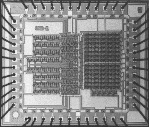![]()


"As far as the laws of mathematics refer to reality, they are not certain; as far as they are certain, they do not refer to reality."
~Albert Einstein

|
|
 |

|
|||||||||||
|---|---|---|---|---|---|---|---|---|---|---|---|---|---|
|
"As far as the laws of mathematics refer to reality, they are not certain; as far as they are certain, they do not refer to reality." ~Albert Einstein |
|
||||||||||||
|
Intorduction:
we present a design of an analogue
fuzzy inference processor with emphasis on the simplicity of architecture,
circuitry and implementation. A brief overview of fuzzy inference processor
building blocks suitable for hardware implementation using analogue Complementary
Metal Oxide Semiconductor (CMOS) techniques will be presented. Techniques
for generalising the design into an n-rule, n-input fuzzy processor have
been established. The design of an analogue fuzzy processor with 4-rule
aggregation is discussed, based on a standard 2mm N-well process.
|
|||||||||||||
|
"Novel analogue fuzzy
inference processor", Published at IEEE International Symposium for Circuits
and Systems, vol 3, pp. 247-250, 1998.
|
|||||||||||||
|
Degree of fuzzification: The degree of fuzzification is determined by the number of Fuzzy Labels, which are used to describe a system using fuzzy rules. These labels may take forms such as Negative Large (NL), Zero(ZE), Positive Large(PL) etc. Seven is generally considered to the optimum number of fuzzy labels implemented in a fuzzy rule system. The scheme adopted in our design uses 7 labels starting from NL at 2.5V and concluding with PL at 8.5V where each label within is 1V away from its neighbour (fig. 5). Back to top
Active Rules: The number of rules required for a fuzzy processor is R =L^I where the number of rules is denoted by R, and the number of fuzzy labels by L and the number of inputs by I. However, at any given time, the majority of rules are idle. Implementation of all rules would therefore lead to redundancy and silicon wastage. Active rules are those that produce a non-zero contribution. The maximum number of active rules (MAR) at any instant is MAR = ( 2 )^ I Back to top
Rule Circuits: With the reduction of the number of rule circuits to MAR, the number of expected active rules of a particular rule set will always be even. Therefore, our design uses a sub-system of 2-rule aggregation, consisting of 4 Membership Function Circuits (MFC) where each rule utilises 2 MFCs. MFCs that are not triggered by any fired rules are switched off by setting their bias currents to zero, removing their contribution to the output. Back to top
Programmability: The ability to share this minimum number of rule circuits relies greatly on their programmability. This is easily achieved using digital modules to instruct each rule circuit of its antecedent triggered rule label, and to generate labels in the consequent by multiplying each normalised rule weight. Back to top
Implementation: The architecture of the proposed design is shown. The centre of gravity stage is implemented using the Normalisation Lock Loop (NLL) technique, which enables the parallel distribution of fuzzy rules to be aggregated instantaneously. Current mode modules are interfaced with ease. Circuit complexity can be further reduced by inverting the membership function, so that a MAX circuit is used, instead of a MIN circuit, in the antecedent. In order to perform inference processing of the algorithm in eqn 1, a truth level is defined for each rule i: Itruth(i) = max( Ai (a), Bi (b) ). Itruth(i) is then normalised by the weight circuit to Iw(i) through a feedback control voltage. The normalised consequent contribution of each rule Iw(i) is multiplied by the weight label Xi of each rule to give the contribution of that particular rule xi. xi = Iw(i) Xi. The NLL computes the centre of gravity by summing n normalised, and weighted currents:
Proposed architecture of the fuzzy processor
The inverted membership function generatot and weight circuit
Fuzzy inference processor layout |
|||||||||||||||||||